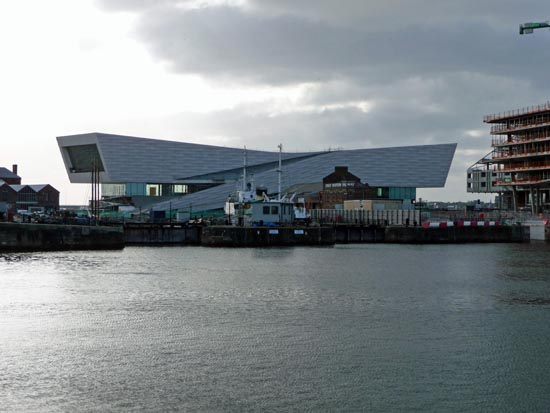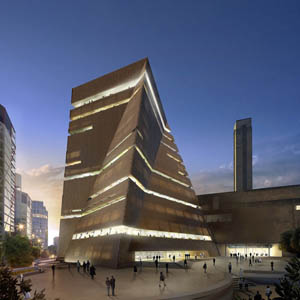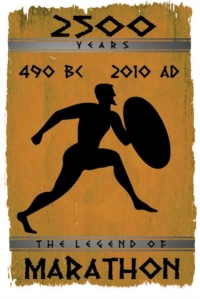Recession, what recession? The cultural-buildings juggernaut rolls on.
Text © Hugh Pearman. An expanded and updated version of article first published in The Sunday Times, London,
3rd January 2010, as "The landmark buildings shaping the next decade".
3rd January 2010, as "The landmark buildings shaping the next decade".

A surprising amount, paid for (in Britain anyway) by a mix of Lottery and taxpayers' money - often helped by European Union grants and private donations - from better times. These places are always about so much more than their contents and function. If the entire magnificent collection of the British Museum were to be housed in a distribution warehouse somewhere, we'd feel short-changed. Even if there was a nice cafι there, and lots of car parking. This was proved the hard way when, back in the 1990s, the Royal Armouries collection moved to a new building in Leeds. It wasn't a bad new building, but it wasn't the Tower of London, where most of the collection had been before. Collapsing visitor numbers, financial embarrassment and a Government bail-out ensued.
In the jargon of the tourism business, the "experience" is what counts. Ever stopped to look at your fellow art-lovers in Tate Modern, for instance? Lots of them (not you, obviously) charge around the place in packs. They don't stop to look at anything much. Dwell time per room is minimal. That's where the huge turbine hall with its annual installations comes into its own. You can get many roaming packs of cultural tourists in there. So the container - this once-overlooked, cathedral-like, postwar power station by Sir Giles Gilbert Scott - is more than up to the task of providing the experience. This is why they need to build an extension. It has more than twice the number of visitors it was designed for. It's just been too damn popular.
 When Swiss architects Jacques Herzog and Pierre de Meuron first came up with an idea for an extension, it was a bit over the top: a stack of glass boxes. That was silly, so version 2 is in brick, like the power station itself. Clever, latticework brick but brick nonetheless. However, the key thing is what the building, with its high-level viewing platform, will do for South London. Tate Modern faces north across the Thames: the symbolism of the fact that its £215m extension will face south, is huge. Visitors to London on 2012 will see it, though tantalisingly it won't be open by then.
When Swiss architects Jacques Herzog and Pierre de Meuron first came up with an idea for an extension, it was a bit over the top: a stack of glass boxes. That was silly, so version 2 is in brick, like the power station itself. Clever, latticework brick but brick nonetheless. However, the key thing is what the building, with its high-level viewing platform, will do for South London. Tate Modern faces north across the Thames: the symbolism of the fact that its £215m extension will face south, is huge. Visitors to London on 2012 will see it, though tantalisingly it won't be open by then.
As Bilbao proved, you don't have to be a capital city to draw the crowds. So I'm intrigued by the much-anticipated £72m Museum of Liverpool, opening of which has now slipped a year to 2011. A sort of stone-and-glass bowtie by Danish architects 3XN, it is right next to the famous "Three Graces" Edwardian Pierhead buildings. The museum looks a bit weird from some angles but is graceful indeed next to some of the other tat which is now being built close by. In what, incidentally, is still a Unesco-designated World Heritage Site. Liverpool has revived strongly in recent years, but continues to score some thumping architectural misses.
READ MORE.....
In the jargon of the tourism business, the "experience" is what counts. Ever stopped to look at your fellow art-lovers in Tate Modern, for instance? Lots of them (not you, obviously) charge around the place in packs. They don't stop to look at anything much. Dwell time per room is minimal. That's where the huge turbine hall with its annual installations comes into its own. You can get many roaming packs of cultural tourists in there. So the container - this once-overlooked, cathedral-like, postwar power station by Sir Giles Gilbert Scott - is more than up to the task of providing the experience. This is why they need to build an extension. It has more than twice the number of visitors it was designed for. It's just been too damn popular.
 When Swiss architects Jacques Herzog and Pierre de Meuron first came up with an idea for an extension, it was a bit over the top: a stack of glass boxes. That was silly, so version 2 is in brick, like the power station itself. Clever, latticework brick but brick nonetheless. However, the key thing is what the building, with its high-level viewing platform, will do for South London. Tate Modern faces north across the Thames: the symbolism of the fact that its £215m extension will face south, is huge. Visitors to London on 2012 will see it, though tantalisingly it won't be open by then.
When Swiss architects Jacques Herzog and Pierre de Meuron first came up with an idea for an extension, it was a bit over the top: a stack of glass boxes. That was silly, so version 2 is in brick, like the power station itself. Clever, latticework brick but brick nonetheless. However, the key thing is what the building, with its high-level viewing platform, will do for South London. Tate Modern faces north across the Thames: the symbolism of the fact that its £215m extension will face south, is huge. Visitors to London on 2012 will see it, though tantalisingly it won't be open by then.As Bilbao proved, you don't have to be a capital city to draw the crowds. So I'm intrigued by the much-anticipated £72m Museum of Liverpool, opening of which has now slipped a year to 2011. A sort of stone-and-glass bowtie by Danish architects 3XN, it is right next to the famous "Three Graces" Edwardian Pierhead buildings. The museum looks a bit weird from some angles but is graceful indeed next to some of the other tat which is now being built close by. In what, incidentally, is still a Unesco-designated World Heritage Site. Liverpool has revived strongly in recent years, but continues to score some thumping architectural misses.
READ MORE.....


